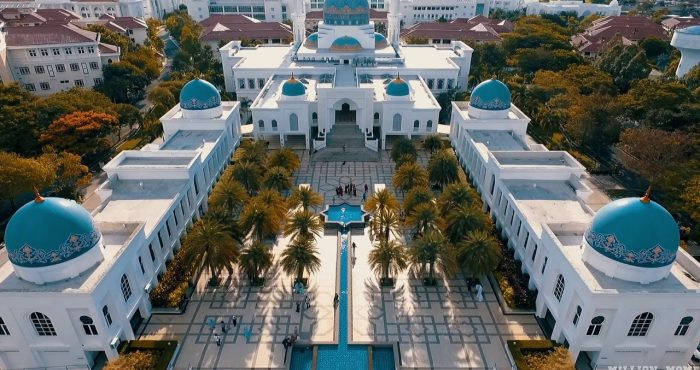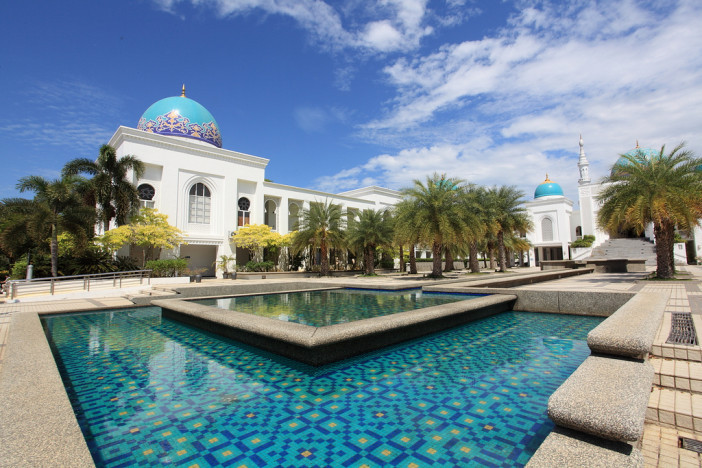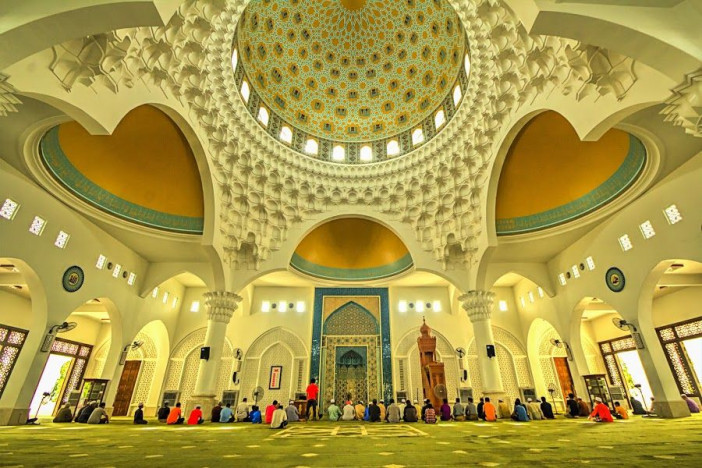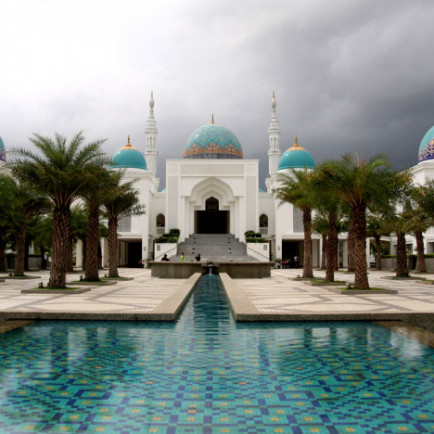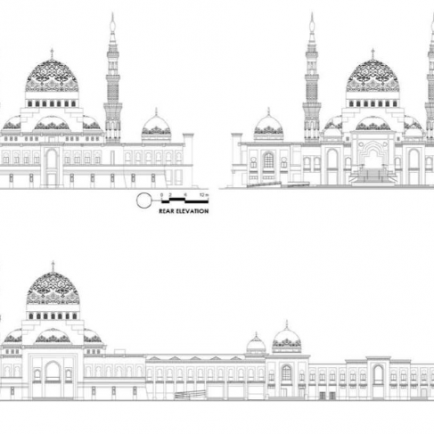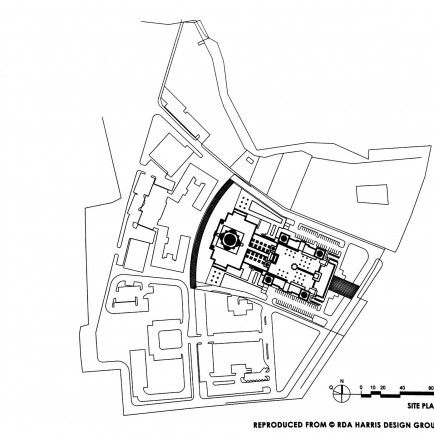Al-bukhary Mosque
History
The mosque was built entirely by the Albukhary Foundation. The ground breaking ceremony was held on 15 January 1999 by Tun Dr. Mahathir Mohamad and construction began in March 2000. The inauguration of this mosque was officiated by KDYMM Tuanku Sultan of Kedah on 22 November 2001 equivalent to 6 Ramadhan 1422H.
Urban and Architectural
This quest enabled the architect to put together many of Tan
Sri Syed Mokhtar Al-bukhary's wishes in the mosque: it resulted in an assembly
or a pastiche of various architectural styles from different islamic countries
that were mixed to become a unique architectural language. The composition is a
myriad blend of architecture designs established through understanding of the differing
styles, their application and suitability, functions and the site context. This
development approach subsequently gave the impetus and had set the direction
for the architectural master-planning of the Al-bukhary International University
campus which was designed by a few selected architects. It was built a few years
later as part of the complex.
Located on a site neighboring a flat plain of paddy fields,
the Northern town of Alor Setar experiences a much hotter and drier climate than the rest of the country.
Thus, in many local dwellings, open spaces with vegetation are a frequent sight
for communal and social purposes. To adapt to the site context and climate, the
Al-bukhary Mosque was designed to maintain this tradition, albeit in more
modern limes and its current environment.
The main courtyard unities the outdoor spaces. Designed with
the use of local green shrubs, it lends formality and is considered part of the
mosque or vice versa. Surrounding the courtyard are ancillary facilities -
classrooms, library, indoor ablutions and toilets and the like. A large fountain
and smaller water features form the centerpiece. The courtyard, pools and soft
landscape lend a cooling, relaxing and peaceful atmosphere for worshippers and
visitors alike.
Arranged in a linear spatial arrangement, the mosque has a strong
visual linkage from the courtyards, the corridors, loggia and galleries,
created in an appropriate human scale. The strong image is accentuated with the
main pointed dome with smaller half domes, among the other seven domes. Its Safavid-influenced
dome was inspired by the Imam Mosque located in Isfahan, Iran. The dome is
flanked with the 47.92 meter (157 feet) twin minarets of Mamluk architecture
and was also influenced by the Al-Masjid Al-Nabawi in Madinah, Saudi Arabia. To
complement the modern architecture, the mosque's elevation is shaped by the use
of various Moroccan-inspired horseshoe and pointed arches placed within a
modern Islamic façade.
Description
Albukhary Mosque is a mosque located in Alor Setar City, Kedah Darul Aman with a distance of about 3 kilometers from the city center. The mosque was built entirely by the Albukhary Foundation.
The mosque is administered by the Albukhary Mosque Management Committee of 13 people which consists of a combination of three parties, namely the Albukhary Foundation, the Alor Malai Parish Committee and the Mosque Officer.
References
https://masjidalbukhary.weebly.com/
https://itc.gov.my/listings/masjid-al-bukhary/
Aziz, A. A., 2016. MASJID - Selected Mosques and Musollas in Malaysia, ATSA Architects Sdn. Bhd.
Details
الموقع
Jalan Langgar, Kedah, Bandar Alor Setar, 05450 Alor Setar, Kedah, Malaysia
عدد المصليين
15,000
المالك / المتبرع
Albukhary Foundation
المعماري
تاريخ البناء
2000
Area
20,072
الرسومات المعمارية
الخريطة
History
The mosque was built entirely by the Albukhary Foundation. The ground breaking ceremony was held on 15 January 1999 by Tun Dr. Mahathir Mohamad and construction began in March 2000. The inauguration of this mosque was officiated by KDYMM Tuanku Sultan of Kedah on 22 November 2001 equivalent to 6 Ramadhan 1422H.
Urban and Architectural
This quest enabled the architect to put together many of Tan
Sri Syed Mokhtar Al-bukhary's wishes in the mosque: it resulted in an assembly
or a pastiche of various architectural styles from different islamic countries
that were mixed to become a unique architectural language. The composition is a
myriad blend of architecture designs established through understanding of the differing
styles, their application and suitability, functions and the site context. This
development approach subsequently gave the impetus and had set the direction
for the architectural master-planning of the Al-bukhary International University
campus which was designed by a few selected architects. It was built a few years
later as part of the complex.
Located on a site neighboring a flat plain of paddy fields,
the Northern town of Alor Setar experiences a much hotter and drier climate than the rest of the country.
Thus, in many local dwellings, open spaces with vegetation are a frequent sight
for communal and social purposes. To adapt to the site context and climate, the
Al-bukhary Mosque was designed to maintain this tradition, albeit in more
modern limes and its current environment.
The main courtyard unities the outdoor spaces. Designed with
the use of local green shrubs, it lends formality and is considered part of the
mosque or vice versa. Surrounding the courtyard are ancillary facilities -
classrooms, library, indoor ablutions and toilets and the like. A large fountain
and smaller water features form the centerpiece. The courtyard, pools and soft
landscape lend a cooling, relaxing and peaceful atmosphere for worshippers and
visitors alike.
Arranged in a linear spatial arrangement, the mosque has a strong
visual linkage from the courtyards, the corridors, loggia and galleries,
created in an appropriate human scale. The strong image is accentuated with the
main pointed dome with smaller half domes, among the other seven domes. Its Safavid-influenced
dome was inspired by the Imam Mosque located in Isfahan, Iran. The dome is
flanked with the 47.92 meter (157 feet) twin minarets of Mamluk architecture
and was also influenced by the Al-Masjid Al-Nabawi in Madinah, Saudi Arabia. To
complement the modern architecture, the mosque's elevation is shaped by the use
of various Moroccan-inspired horseshoe and pointed arches placed within a
modern Islamic façade.
Description
Albukhary Mosque is a mosque located in Alor Setar City, Kedah Darul Aman with a distance of about 3 kilometers from the city center. The mosque was built entirely by the Albukhary Foundation.
The mosque is administered by the Albukhary Mosque Management Committee of 13 people which consists of a combination of three parties, namely the Albukhary Foundation, the Alor Malai Parish Committee and the Mosque Officer.


